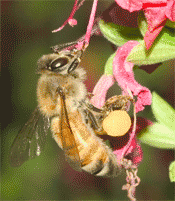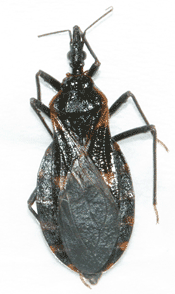 Colony Collapse Disorder, or CCD, has certainly had its fifteen minutes of fame over the past two years. A serious problem for commercial beekeepers, this new threat to managed honey bees has puzzled researchers. For an up-to-date report from the leading U.S. research team, check out the new article in Scientific American magazine. According to researchers, pesticides, often singled out as a likely culprit in bee die-offs, have not been ruled out as a factor in colony deaths, but less likely as a prime cause. New molecular techniques seem to point to a recently discovered virus as the principal suspect.
Colony Collapse Disorder, or CCD, has certainly had its fifteen minutes of fame over the past two years. A serious problem for commercial beekeepers, this new threat to managed honey bees has puzzled researchers. For an up-to-date report from the leading U.S. research team, check out the new article in Scientific American magazine. According to researchers, pesticides, often singled out as a likely culprit in bee die-offs, have not been ruled out as a factor in colony deaths, but less likely as a prime cause. New molecular techniques seem to point to a recently discovered virus as the principal suspect.
Thursday, March 19, 2009
Pennsylvania researchers summarize progress on Colony Collapse Disorder in bees
 Colony Collapse Disorder, or CCD, has certainly had its fifteen minutes of fame over the past two years. A serious problem for commercial beekeepers, this new threat to managed honey bees has puzzled researchers. For an up-to-date report from the leading U.S. research team, check out the new article in Scientific American magazine. According to researchers, pesticides, often singled out as a likely culprit in bee die-offs, have not been ruled out as a factor in colony deaths, but less likely as a prime cause. New molecular techniques seem to point to a recently discovered virus as the principal suspect.
Colony Collapse Disorder, or CCD, has certainly had its fifteen minutes of fame over the past two years. A serious problem for commercial beekeepers, this new threat to managed honey bees has puzzled researchers. For an up-to-date report from the leading U.S. research team, check out the new article in Scientific American magazine. According to researchers, pesticides, often singled out as a likely culprit in bee die-offs, have not been ruled out as a factor in colony deaths, but less likely as a prime cause. New molecular techniques seem to point to a recently discovered virus as the principal suspect.
Monday, March 16, 2009
Study on risks of Chagas disease in Texas
 If you think bed bugs are creepy, consider the kissing bug. This insect, like the bed bug, comes out primarily at night for its blood meals. Much larger than the bed bug, some kissing bugs approach an inch in length. Also, unlike the bed bug, kissing bugs are known to carry a serious illness, called Chagas disease, that can affect humans.
If you think bed bugs are creepy, consider the kissing bug. This insect, like the bed bug, comes out primarily at night for its blood meals. Much larger than the bed bug, some kissing bugs approach an inch in length. Also, unlike the bed bug, kissing bugs are known to carry a serious illness, called Chagas disease, that can affect humans. In a new paper published in the journal Vector-Borne and Zoonotic Diseases, researcher Sonia Kjos and associates describe first survey of the kissing bug species in Texas in many years. Using new DNA-based techniques they were able to tell how many of the insects they collected were infected with the parasite.
The study confirms the presence of kissing bugs through most areas of Texas (97 of 254 counties), and shows that over half the bugs collected from domestic settings tested positive for the disease pathogen. Dogs seem to be especially at risk for the disease where these bugs are present, possibly because they may eat the bugs whenever they can. Over 530 cases of Chagas disease have been confirmed in dogs in Texas over the past 15 years.
Ready for some good news? The disease, for reasons not fully understood, remains very rare in humans in Texas. Only 6 cases have been confirmed since 1955 when the first incident was recorded in the medical literature. Tighter house construction and different sanitation standards could account for the lower infection rates in Texas compared to northern Mexico, where some of the same kissing bug species are found. In any case there is much more to be learned about this secretive and creepy bug. In the meantime, thanks to Sonia and her team for shedding a little more light on this important pest and disease.
New Handout on Crazy Ants
 Depending on your perspective, the new crazy ant species discovered by Texas A&M researchers with the help of Houston PMP Tom Rasberry either has you excited about the prospect of new revenue, or shaking in your boots. Personally, I dread new exotic pests. Exotics are a lot easier to get than get rid of, and the ultimate spread and impact of this pest is still anyone's guess.
Depending on your perspective, the new crazy ant species discovered by Texas A&M researchers with the help of Houston PMP Tom Rasberry either has you excited about the prospect of new revenue, or shaking in your boots. Personally, I dread new exotic pests. Exotics are a lot easier to get than get rid of, and the ultimate spread and impact of this pest is still anyone's guess.A new resource is available through the Texas AgriLife Extension public website that explains the new pest succinctly and gives consumer practical suggestions on what they should do if they suspect they have the Caribbean (aka Rasberry) crazy ants. If you have not thought about using AgriLife Extension publications in your business, now may be the time to start. Many useful publications are available online for linking to through your company's website, or for printing and distribution to customers, or potential customers.
By the way, the handout notes that at the present time the only practical recourse for dealing with these ants is professional pest control. And in case you think that this new pest is not anything to be concerned about in your part of the state, you might want to think twice. The new crazy ant species has spread to 11 counties within a few years, and there is no reason to think that it won't continue to spread, especially east and south.
And if you eventually end up with these ants in your neighborhood, you may live to rue the day when you looked forward to seeing these ants for the revenue they can generate. There's little satisfaction in a pest that's very difficult to control.
Friday, March 6, 2009
New Rules for Schools
 The new proposed rules that will govern how Texas schools conduct their pest management programs were published today in the Texas Register. The rules can be found online at http://www.sos.state.tx.us/texreg/sos/PROPOSED/4.AGRICULTURE.html#95
The new proposed rules that will govern how Texas schools conduct their pest management programs were published today in the Texas Register. The rules can be found online at http://www.sos.state.tx.us/texreg/sos/PROPOSED/4.AGRICULTURE.html#95In my opinion, the Texas Department of Agriculture has done a good job listening to schools and the pest control industry, as well as our concerns in the public education sector. That said, I encourage anyone with concerns about the impact of these rules to participate in the public comment period.
These public comments do make a difference. In fact, the comments made during the last round, when the rules were first published, forced the agency to go back to the drawing board and review what they had proposed. The second version, represented by today's rules, is much improved.
We have 30 days from today to get comments and suggestions about the new rules to the TDA. Written comments are the preferred method, and probably the only chance to be taken seriously by the process. Send your comments to Mr. Jimmy Bush, Assistant Commissioner for Pesticide Programs, Texas Department of Agriculture, PO Box 12847, Austin, Texas 78711.
New since the last advisory committee is a definition of IPM for schools. This was something I noted in my last blog on the subject had been avoided until now. I think they did a good job with the definition. To recap then, some of the most important impacts these rules will have on the way we do pest management in Texas schools include:
- all school IPM coordinators (IPMCs) will be required to attend training on a regular basis (a minimum of six hours every three years);
- the definition of IPM is made more clear under the new rules and will require all schools to
have monitoring programs, keep an organized record-keeping system, develop an education plan for school district employees, and have written thresholds for important pests; - non-pesticide control measures will be exempt from posting requirements;
- the existing criteria for Green category pesticides will be retained and clarified;
- the reentry interval for students after pesticide applications will be shortened from 12 to 4 hours in most cases, and reentry for Green category products will be allowed as soon as sprays have dried;
- outdoor areas of pesticide application will require posting at time of application for duration of the required reentry interval.
Tuesday, March 3, 2009
Horizontal transfer of fipronil among termites
 Sometimes a scientific fact is known within the research community long before it comes out in print. This is the case with a paper published in the latest issue of the Journal of Economic Entomology.
Sometimes a scientific fact is known within the research community long before it comes out in print. This is the case with a paper published in the latest issue of the Journal of Economic Entomology.In a paper by Bagnères et al (J. Econ. Entomol. 102(1): 347-356) the ability of fipronil to be picked up by foraging termites, both by simple contact with treated sand, and by ingestion of treated filter paper. According to one of the authors, Bob Davis of BASF Corporation, this study represented the first scientific evidence that fipronil is transferred horizontally among termite colony members.
The horizontal transfer phenomenom has been suspected for several years since it was observed that termite activity in monitoring stations consistently ceased when stations were close to fipronil-treated soil. While this doesn't mean that transfer of fipronil results in death of colonies, it does offer a possible explanation of the good track record for perimeter-only treatments for termite infested homes.
To see an abstract of the paper you can go to http://www.ingentaconnect.com/content/esa/jee/2009/00000102/00000001/art00046
Subscribe to:
Comments (Atom)